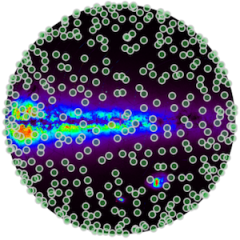Exercise with a list of SDSS galaxies
We assume that the abell2065_2deg_radius.csv file is in ~/mpe2018/Data otherwise change the file path as appropriate. Can download it from here.
You can download any additional data set querying the SDSS Skyserver.
Columns description:
objid => unique identifier (numeric) of the object rad => Right Ascension (fractional degrees) decd => Declination (fractional degrees) u g r i z => magnitude of the object in these filters redshift => z specobjid => unique spectrum ID
As usual, the mysql> prompt is omitted. The database is always mpe2018db.
Have a look to the file with a text editor, or e.g. just
head -5 ~/mpe2018/Data/abell2065_2deg_radius.csv
Manually create the table to host the catalogue:
use mpe2018db; CREATE TABLE sdss_sample ( objid bigint NOT NULL, rad double NOT NULL, decd double NOT NULL, u float DEFAULT NULL, g float DEFAULT NULL, r float DEFAULT NULL, i float DEFAULT NULL, z float DEFAULT NULL, redshift float DEFAULT NULL, specobjid bigint NOT NULL ) engine=MyISAM;
Load the CSV file into the table via LOAD DATA (we use explicit clauses for clarity – see the MySQL reference page), describe the content, count the number of rows (galaxies) in the catalogue, print the first five rows:
load data local infile '~/mpe2018/Data/abell2065_2deg_radius.csv' into table sdss_sample FIELDS TERMINATED BY ',' ENCLOSED BY '' ESCAPED BY '\\' LINES TERMINATED BY '\n' STARTING BY '' IGNORE 2 LINES; describe sdss_sample; select count(*) from sdss_sample; select * from sdss_sample limit 5;
Let’s preform some queries. Here we investigate the extreme redshift ranges.
select * from sdss_sample where redshift > 3.; -- 3 found select * from sdss_sample where redshift > 1. and redshift < 3; -- 7 found select * from sdss_sample where redshift < 0.00001; -- 4 found select objid, r, u-r as color from sdss_sample order by color asc limit 3; select objid, r, u-r as color from sdss_sample order by color desc limit 3; select objid, r, g-r as color from sdss_sample order by color desc limit 3;
Exercise with more queries of your choice. I suggest to perform queries to identify the number of objects in r magnitude ranges and (g - r) color. We'll see these data in a graphical way too.
